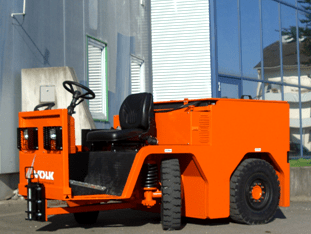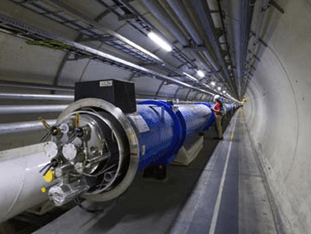On Collision Course – VOLK Electric Tractors at the European Nuclear Research Center
It is a superlative project. About 100 meters below the surface of the earth, in the border area between Switzerland and France, the largest technical test facility ever conceived of by humans was put into operation in 2008: the Large Hadron Collider (LHC), a gigantic underground particle accelerator which stretches from Lake Geneva to the French Jura mountain range on a ring-shaped path. 10.000 scientists and technicians from over 100 countries were involved in the construction of the gigantic plant. Electric tractors from VOLK also contributed to the success of the project.

VOLK Electric Tractor EFZ 30 K – Probably the most compact tow tractor for 30 tons load currently on the market
The research goal of the scientists is the creation and accurate investigation of known and still unknown elementary particles and matter states. On two opposing tracks, hydrogen atoms, so-called protons, are accelerated almost to the speed of light in order to allow them to collide head-on at defined points. In this way the scientists simulate for a few fractions of a second the conditions which existed at the time of the Big Bang around 15 billion years ago. The research results are recorded in four detector systems, which are accommodated in gigantic underground halls. The experimental proof of existence of the so-called Higgs boson, which led to the award of the Nobel Prize for Physics in 2013 to François Englert and Peter Higgs, is regarded as the greatest success of the project so far.
But before this could happen, the construction and development engineers first had to do all the work: The various components were first transported about 100 meters under the earth’s surface via cargo cranes. Then they were pre-assembled in the four cathedral-like detector halls before being transported to their final destination through the narrow tunnels.
The 1.232 dipole magnets which had to be evenly distributed in the 27 km long ring-shaped system to keep the protons in their orbit during the experiments represented a special challenge. Every single one of these cylinder-shaped magnets is 15 meters long and weighs at least 30 metric tons. This is a transport task which could only be handled by extremely compact and powerful electric tractors.
One of the dipole magnets in the underground tunnel system of the Large Hadron Collider (LHC)

For tasks like this, the CERN used VOLK Electric Tractors of type EFZ 30 K. With their 20 KW AC drive, they achieve a drawbar pull of up to 20.000 N and therefore can tow loads of up to 35 metric tons. With a length of only 2.50 meters, a width of only 1.25 meters and a turning radius of only 2.83 meters, they are ideally suited to use in the narrow corridors of the LHC.
So that they do not get puffed out eventually in the kilometers of tunnels, the vehicles have a traction battery with an impressive capacity of 80 V / 560 Ah. “Our employees sometimes jokingly refer to this vehicle as a traction battery with a front axle”, says VOLK Managing Director Dr. Matthias Baur, not without also smiling himself.
While this sounds funny, the battery capacity has been a decisive criterion for the persons in charge at CERN. Most compact tow tractors on the market have a rather small battery capacity. And in the narrow corridors of the LHC, it would be quite difficult to recover a stranded vehicle with a flat battery.

VOLK Fahrzeugbau GmbH
Stahlstraße 15
88339 Bad Waldsee
+49 7524 9709 0
info@volk.de
